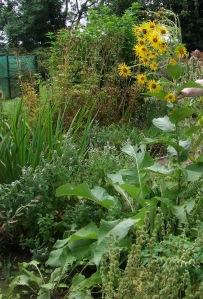Yesterday we were fortunate to have the expertise of a professional sharing her passion for herbs with us. A qualified herbalist, Catherine Schofield, offered to spend a few hours in the chapel and walled garden with an interested group from the Friends of Chadkirk.

Apparently we’ve the Romans to thank for the Lavender. Or at least for bringing it to Britain. Though we’ve also to thank the Celts, the Druids, Augustine Monks, the Arabs, the Myddfai family of Carmarthen, Culpepper and Modern Science. Each in their own way having contributed to our current understanding of the way plants can support our health and well being.
Although many of the herbal remedies fell from favour, current scientific research is providing information which tells us more about how they work and to support their use in the hands of a skilled practitioner. Extracts from plants as wide ranging as stinging nettles, foxgloves and teasels can have beneficial effects. For some plants there was a long list of anti-s. Anti- microbial, anti-fungal, anti- bacterial, anti-inflammatory, anti-histamine. All helpful in a world without antibiotics and modern disinfectants.
Since some of the knowledge gleaned in the past has been lost, or hidden, there were bound to be a few oohs and aaahhhas as Catherine unfolded the story of a few of our common herbs. Of mullein being used as a kind of pre-industrial firelighter (hence the folkname of torch weed).Of pieces of elecampane chewed to banish toothache, or reduce asthmatic spasms. Of teasel flower heads being used in the wool trade.
Among the many contemporary uses for herbs, the favourite might have been something Pat heard from American visitors. They made good use of lovage: drinking their cocktails through the stalks.
Before you dash to emulate them, a cautionary warning. There are poisonous plants out there. Without sufficient expertise for correct identification and the knowledge required for their safe use they can be harmful. Can you be sure of the differences between Hemlock and Angelica? The right dose of one can help digestion if you suffer from low stomach acid and an extract from the other will kill.

A cure for loose teeth?
Pieces of roots from elecampane were candied, coloured red and chewed.
After the loss of so much of the folklore and experience of previous generations, it’s good to know that we can all find out more. On the history of herbs Catherine recommended The Green Pharmacy by Barbara Griggs. Information about herbs and their uses can be found in “A Modern Herbal” by Maud Grieve, originally published in 1931 but also available on-line:
A Modern Herbal | Elecampane.
You can find out more about the use of plants in the Middle Ages by looking into what archaeoethnopharmacologists discovered from excavations such as those at Soutra.
Soutra Aisle – Medieval life – Scotlands History.
BBC NEWS | Health | The medical world of medieval monks.
Catherine Schofield Herbal Medicine – Home.




